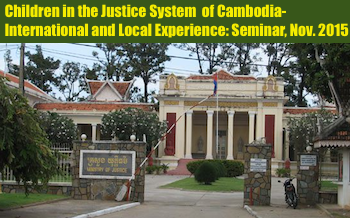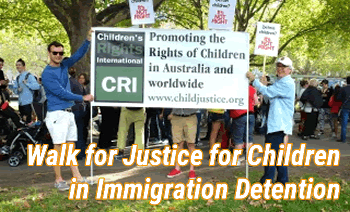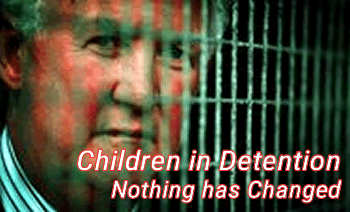 Constitutional change is key to a strong treaty with Indigenous Australians
Constitutional change is key to a strong treaty with Indigenous Australians
by the Hon. Alastair Nicholson AO, RFD, QC
Published in Arena Magazine no. 141, April-May 2016: www.arena.org.au
The Aboriginal leader Djiniyini Gondarra has said:
‘The survival of the Aboriginal people relies on changes to the Constitution and the establishment of a Treaty. The Treaty needs to be born out of the people who have a strong connection with land, culture, spirituality and law rather than being established by government or a committee formed by government. It should be established by the people that maintain tradition because the necessary tools are already in place.’
The purpose of this article is to support the views expressed by Djiniyini Gondarra in the above quote: first, the need for changes to the Constitution; second, the establishment of a treaty; and, third, that it needs to be born out of the people concerned, who have a strong connection with land, culture, spirituality and law, rather than being established by government or a committee formed by it.
Much recent discussion about the future for Aboriginal and Torres Strait Islander peoples has related to constitutional change and treaty as if they were opposing concepts. While the move in favour of a treaty is very much to be welcomed and I have been impressed by the support that it has gained, in my view it is a mistake to treat constitutional change in this way. I think it better to regard it and treaty as component parts of the same jigsaw. I think that Djiniyini Gondarra is right about the order of what should occur. It would, I believe, be a serious mistake to attempt to negotiate a treaty in advance of and without supporting constitutional change. I am therefore very concerned about the either/or approach that has developed.
This article had its genesis in the above quote and the comments that I made at the launch of a book that contained it, which led to an invitation to further elaborate upon those comments.I would like to start with a disclaimer. A person of my background cannot hope to understand the nuances of Aboriginal and Torres Strait Islander cultures or to put myself in their position, given their treatment by white governments and people in the last 228 years, and I am not attempting to do so. Any comments that I make are as a former judge and lawyer with sympathy for and a degree of understanding of their cause. I seek simply to draw attention to problems surrounding these difficult issues as I see them.
I have during the course of this article referred to a national treaty, but that is not to say that there should be only one treaty, although it should be said that the effect of one significant document might be greater than having a number of them. I should also say that I have used the word ‘treaty’ because I realise its significance to Aboriginal and Torres Strait Islander peoples. However, it should be remembered that ‘treaty’ is simply another word for ‘agreement’, and the latter may carry fewer emotional overtones for those who are inclined to oppose a treaty.
The decisions as to what they want must be made by Aboriginal and Torres Strait Islander people themselves, but any real change needs the consent of a majority of all Australians, and, for constitutional change, a majority of voters in a majority of states.The last point is important, for the states are significant players, and the problems about a national treaty include how and whether the states should be involved. I note that Victoria has expressed interest in a treaty, and the Canadian example demonstrates the efficacy of provincial treaties in that country. There may be issues of the extent of Commonwealth and state powers to make a treaty in Australia that will need to be addressed in this regard. This is not to say that the possibility of such treaties should not be fully explored and the Victorian government is to be commended for taking this step.
However, the direct involvement of the states in negotiations for a national treaty would make it difficult, if not impossible, to reach agreement. If a constitutional amendment empowered the Commonwealth to make a national treaty the issue would not arise, but it is nevertheless important that the states, as far as possible, are supportive of such a treaty.
Like many, I have difficulty in seeing constitutional change in itself as meeting all of the legitimate aspirations of Aboriginal and Torres Strait Islander people. Nevertheless, I think that constitutional change is highly desirable and may well be vital as a forerunner to a national treaty. There are aspects of constitutional change that could greatly strengthen the position of Aboriginal and Torres Strait Islander peoples, particularly as the Constitution offers no human-rights protection and enables the government to pass legislation detrimental to their interests.
Achieving appropriate constitutional change is difficult, though not impossible, but constitutional content can never descend to the level of detail that one would expect to find in a treaty and therefore a treaty is a matter of vital importance. In order to succeed, amendments to the Constitution must be succinct, easily understood and broadly acceptable to the major political players in the Commonwealth and the states as well as to Aboriginal and Torres Strait Islander peoples.
When speaking of constitutional change, it is obviously important to define what sort of change is meant. A number of suggestions for constitutional change, such as the Howard Government proposal for a preamble, have been worse than useless. Others involving the recognition of Aboriginal and Torres Strait Islander peoples as first peoples might have symbolic significance but not much more.
However, the proposals of the expert panel for amendment of the Constitution do not seem to me to be objectionable in themselves. The proposed new section 51A goes further than simple recognition by requiring that the power of the federal government to pass laws in relation to Aboriginal and Torres Strait Islander peoples must be used for the benefit of these peoples. Similarly, the suggested removal of powers to pass racially discriminatory laws and restrict people from voting based on race seems sensible, as does proposed section 116A, which would ban racial discrimination by government (although the previous prime minister stated that this change is unacceptable, presumably because of its human-rights implications). Arguably the proposed constitutional amendments do not go far enough, but I think they represent an advance on the present situation.
There is a particular problem about the proposals, though, and that is that the views of the Aboriginal and Torres Strait Islander people have not been taken into account in formulating them. The present proposals are both hurried and limited, and other changes should be considered.
In my view, the sort of constitutional change that would be most beneficial is one that would empower the Commonwealth to enter into negotiations for, and to make a treaty with, Aboriginal and Torres Strait Islander peoples that is binding on the Commonwealth and the states and territories. This could be addressed as a simple and easily understood referendum question that might well receive the support of the major political parties in Australia and the majority of the people of Australia. While acknowledging the force of support for this proposal, however, the expert panel did not recommend it in its 2012 report.
The proposal is not new. It appears to have been first made in the early 1980s, and in 1983 the Senate Standing Committee on Constitutional and Legal Affairs recommended the insertion of such a provision in the Constitution. The Hawke Government indicated its agreement to make a treaty but took the matter no further. It is only comparatively recently that the treaty proposal has been revived, and it is receiving strong support from Aboriginal and Torres Strait Islander peoples.
The issue was revived at the 2020 summit convened by Prime Minister Rudd in 2008. I participated in the Indigenous stream along with Indigenous and non-Indigenous people, among them political scientist and author Sarah Maddison, where the concept of a treaty was discussed.
In her book Black Politics, Maddison records witnessing an emerging consensus in relation to legal recognition, preceded by a commitment to a national dialogue on the issue. She notes that there was no division between those wanting a treaty and those wanting constitutional reform. As she correctly records, by the end of the first day the 100 delegates had agreed on three priority areas, each of which went to the question of unfinished business.
These areas were, first, the initiation of a national dialogue towards forming a legal basis for the relationship between Indigenous and non-Indigenous Australians. The form of the arrangement was left open, although by the end of the second day a preference for constitutional change seemed to have evolved.
Secondly, the group envisaged the creation of a reconstruction fund perhaps based on a percentage of GNP, which would be directed to the rebuilding of core services in Aboriginal communities.
The third key area was prioritising the development of a new cultural framework for Australia that places Aboriginal culture at the centre through the creation of a Cultural Heritage Authority and new cultural symbols.
I realise that the first conclusion rather favoured the argument for constitutional change as opposed to a treaty or agreement. However, for the reasons stated above I think that both are necessary. In any event I found it encouraging that such a widely disparate group of people could conduct a sensible dialogue over two days and arrive at a reasonable consensus to go forward. In this dialogue no one was negotiating from a position of power and, for me at least, it gives a pointer to what might be achieved by such a process on a larger scale.
Maddison has more recently commented that enabling agreement-making in this way would give Aboriginal and Torres Strait Islander peoples in Australia some of the political status afforded Indigenous people in other parts of the world, including the United States, where representative organisations are able to facilitate a government-to-government relationship that includes the negotiation of specific agreements. This form of strong recognition, which would enable an acknowledgement of Aboriginal and Torres Strait Islander peoples’ collective interests, would do much to address their historical exclusion and belatedly admit them as parties to Australian nation-building endeavours. Maddison cited a February 2003 article by Tim Rowse, ‘Indigenous Australia: Treaty Talk’, in support of these remarks. Her view is that ‘a new relationship on these terms, built on the capacity for organisations like the National Congress of Australia’s First Peoples to make formal agreements with the Commonwealth, would dramatically change the political context and representational capacity of Aboriginal and Torres Strait Islander peoples’.
This type of proposal, based on a model in section 105A of the Constitution in relation to state-government debt, is also discussed in Treaty, by Sean Brennan, Larissa Behrendt, Lisa Strelein and George Williams. This model could constitutionally bind federal, state and territory parliaments to act consistently in accordance with the terms of the treaty.
The authors of Treaty also discuss a model proposed by Mick Dodson that involves best practice in current agreement-making with Indigenous people in Australia and overseas and sets minimum standards for a framework for future negotiations that could be incorporated in the Constitution. The authors suggest that this could be included in a section 105A model to be incorporated in a single referendum question amending the Constitution.
There are no doubt other amendments that should be made, but care must be taken to avoid overcomplicating the questions or having too many of them, because any negative controversy could destroy the whole exercise.
I understand the many objections of Aboriginal and Torres Strait Islander people to giving legitimacy to a document like the Constitution, which not only excluded and ignored Aboriginal and Torres Strait Islander peoples at its inception but actively discriminates against them even today. It has many other deficiencies, including its failure to recognise human rights (which affects all Australians) and the fact that it can be and has been used to enact legislation contrary to the interests of Aboriginal and Torres Strait Islander peoples.
However, while the many criticisms of the Constitution are undoubtedly valid, the problem is: what follows from this? It is not about to go away, and my point is that if real progress is to be achieved the Constitution must be changed in a way that gives it greater legitimacy and opens the way for an enforceable treaty.
The fact that Aboriginal and Torres Strait Islander peoples never ceded sovereignty is at first sight a powerful argument against the acceptance of the Constitution. An important issue in this discussion is: what does sovereignty really mean? Is it the simple view that sovereignty means the right to govern unchallenged, or can sovereignty be shared? If the former, it is impracticable to rely upon the sovereignty argument because it is inconceivable that history can be turned around to restore that sort of sovereignty to Aboriginal and Torres Strait Islander peoples. If it is the latter, as I believe to be the case, then sovereignty remains an important issue in any treaty negotiations.
In the Australian context, sovereignty is already shared between the Commonwealth and the states, with the Commonwealth having responsibility for defined heads of power such as defence and Australia’s external relations with other countries, and the balance lying with the states.
Similarly, sovereignty could be shared with Aboriginal and Torres Strait Islander people in relation to many significant issues that could form the subject of a treaty. This could include a number of interesting possibilities, such as the incorporation of the principles of the UN Declaration on the Rights of Indigenous Peoples (UNDRIP) into the treaty and thus into Australian law, or the creation of self-governing territories like Canada’s Nunavut—areas like the Torres Strait, Arnhem Land and the Tiwi Islands are possibilities, and there may well be others.
The expert panel reporting to the prime minister in January 2012 refrained from making a recommendation for a treaty or for constitutional recognition of sovereignty, but it might be said that it balked at these hurdles too quickly, because, as I have suggested, an amendment to the Constitution permitting the making of a treaty would not automatically produce a concession as to sovereignty but would simply leave it as one of the matters to be negotiated in the course of treaty discussions. This would enable a sensible discussion of the type of sovereignty that might be recognised by the treaty without raising the emotive issues involved at a referendum.
The High Court’s decision in Mabo makes it clear that the existence of Aboriginal and Torres Strait Islander law prior to 1788 is accepted and that the two systems of law can stand together.
I can well imagine that a treaty is a real possibility, but Aboriginal and Torres Strait Islander peoples must have independence and equal bargaining power to make it. Most importantly, it must be enforceable and binding upon governments.
The behaviour of recent Australian governments and their attitude towards solemn international treaties such as the UN Convention on the Rights of the Child and the Refugee Convention gives one little confidence about a future government’s approach to a treaty with Aboriginal and Torres Strait Islander peoples without constitutional backing.
Would legislation incorporating a national treaty be sufficient? A treaty supported by legislation is a doubtful solution when one remembers that in 2007 the Howard Government, with the support of the then Rudd Opposition, suspended the Racial Discrimination Act to support the Northern Territory Intervention. Labor when in government then took three years to reinstate the Act, despite its pre-election promise to do so, and effectively continued with the Intervention. This was a tremendous breach of faith by both major political parties and indicative of their preparedness to ride roughshod over human rights contained in legislation when it suited them. A treaty without constitutional guarantees would be liable to receive the same treatment.
New Zealand’s Treaty of Waitangi is often given as an example of the successful use of a treaty, and in a modern context this is undoubtedly correct. Since at least the 1960s it began to be the subject of discussion between Maori peoples and government, and since the 1975 Waitangi Tribunal Act it has been given recognition in many other pieces of legislation. However, for the purposes of my present argument it is important to remember that it was left in abeyance for almost 120 years and it still does not occupy the position that a constitutionally recognised treaty would in Australian law. It is to be noted that NZ Chief Justice Dame Sian Elias has suggested its possible incorporation into a future NZ Constitution.
Legislation can always be changed, so it does not provide a means of ensuring the permanent and binding nature of a treaty. A possible qualification might be that the negotiation of a treaty recognised as enforceable by legislation could be a precursor to acceptance of the need for constitutional change.
The difficulty about this approach is that it must be recognised that the negotiation of a treaty is likely to be a complex process that could take many years, and it may have to be undertaken in stages, as the Canadian experience shows. Also, Aboriginal and Torres Strait Islander peoples would be left in a significantly less powerful negotiating position than the other party or parties if such a treaty were only to be confirmed by legislation. It is clear that they would be in a much more powerful position if the Constitution were amended to authorise the federal government to enter into such a treaty, which would be binding on all parties and the states and territories.
It is beyond the scope of this article to discuss the mechanism for the making of a treaty. However, I would agree that the guiding principles are appropriately set out in the quote from Djiniyini Gondarra at the commencement of this article.
Similarly, it is beyond the scope of this article to discuss how Aboriginal and Torres Strait Islander people should be represented in such negotiations, and in any event that is a matter for them. In this regard I note that Tony McAvoy, the first Indigenous senior counsel, has drafted a charter for an Assembly of First Nations People to negotiate the terms of treaties at both federal and state level. This would appear to be a possible beginning of the development of a National Congress of Australia’s First Peoples.
In conclusion, I respectfully urge the proponents of a treaty or treaties, or agreements—however named having the same effect—to look at the whole issue in the context of amending the Constitution to make any such instruments effective and to look at other proposals to amend the Constitution, including the recognition proposal, on their own merits and not as mutually exclusive. If the actual proposal for change goes no further than that advanced by the expert committee, that should be regarded as a beginning rather than the end of constitutional change. However, before that point is reached the views of the Aboriginal and Torres Strait Islander peoples should be obtained and properly taken into account. If they support the treaty concept, that should be included in any referendum.
31 March 2016
See:














